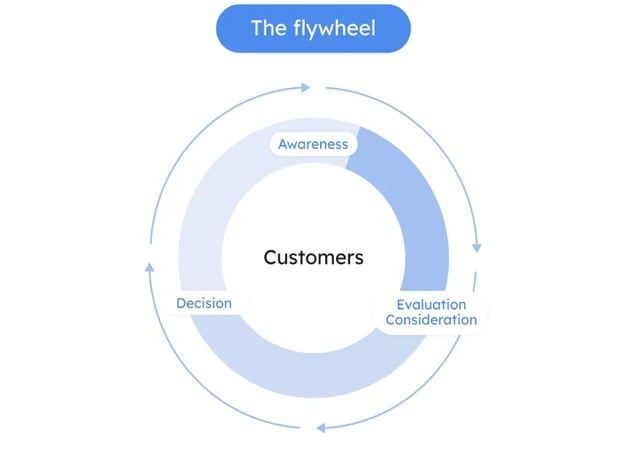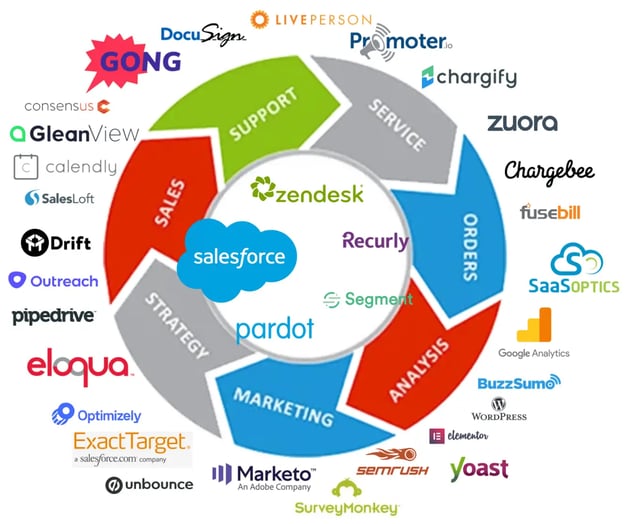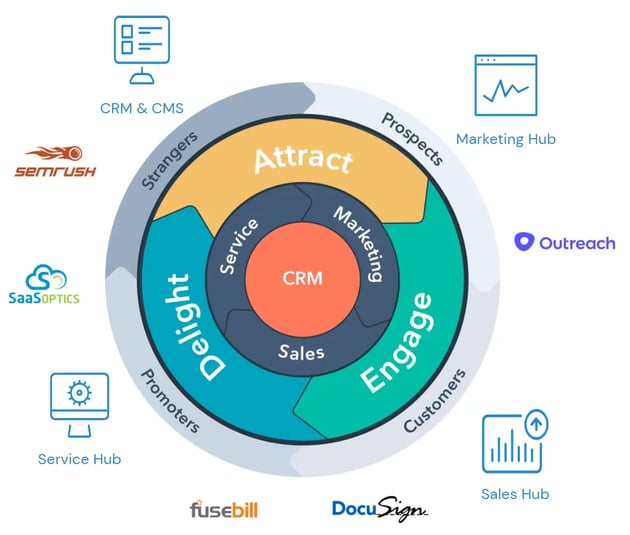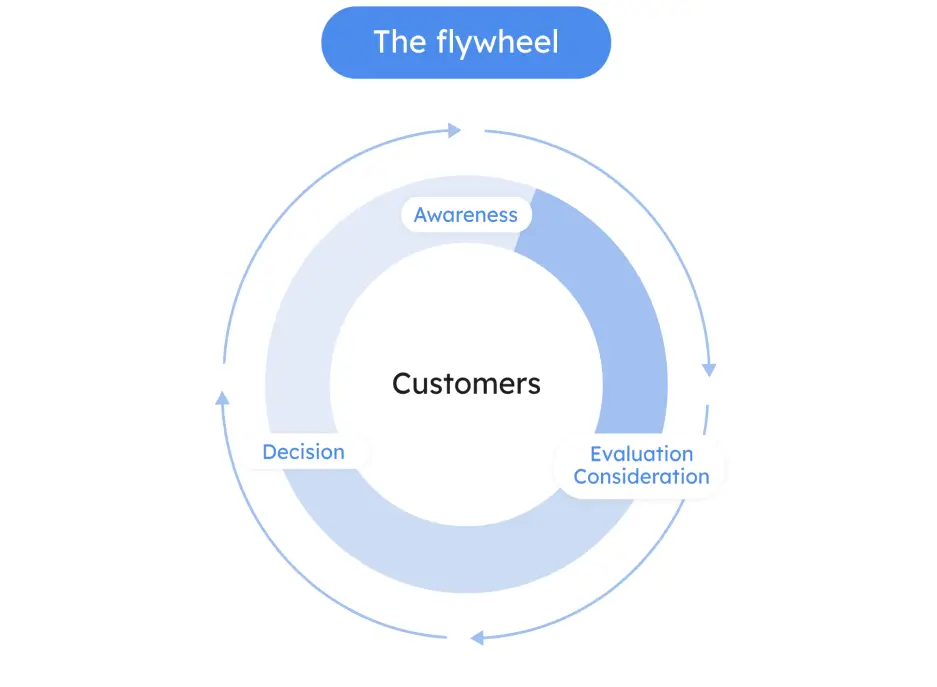TLDR: For B2B SaaS Ventures under $25-30M ARR, HubSpot is the best CRM on the market in 2025.
These days, the Marketing Technology Market (MarTech) is so crowded that choosing an adequate CRM is tricky. In fact, since 2011, the MarTech industry has grown by a whopping 6521%. You read that right, 6521% 🤯. It’s exciting and overwhelming. The barriers to entry in the space have lowered so much that many more bright minds have entered the arena and helped push innovations forward. Though, the never-ending wave of new solutions can be a trap to most B2B SaaS ventures and their long-term growth. While it’s great to see sophisticated customer data platforms (CDP) appear every year, too many options is sometimes synonyms with no option.
Nowadays, marketing leaders and CMOs spend more on technology than CIOs. Choosing the right solutions for your company is a struggle shared by many B2B SaaS companies. This blog offers a framework that helps you choose the CRM that will support the needs of your business.
1. What CRM do you need, and for what?
It might seem obvious, but knowing what you are looking for before starting your research can save you a lot of time.
At Kalungi, we're familiar with the technology needs of B2B SaaS companies and discuss them daily with B2B SaaS leaders (CEOs, VP of Sales, VP of Marketing). We concluded that technology needs could be divided into three categories.
The first one is finance. This is everything related to accounting, inventory, and invoices.
The second is HR, to help manage payroll, hiring, training, personal reviews, and goal settings. (There are tools like PrimePay software, for example, that can simplify payroll and HR processes.)
The third one, and maybe the most complex one, is a combination of marketing, sales, and customer success.
These three are grouped together because, in 2025, a successful go-to-market (GTM) strategy for B2B SaaS venture cannot succeed without the alignment of the marketing, sales, and customer support departments. Hence the soaring number of solutions in MarTech. This blog focuses on the ladder.
2. One CRM for Marketing, Sales, and Customer Success.
In 2025, these three activities are not divided into separated departments anymore but rather cohabitate in symphony. Whether in the B2B or the B2C worlds, customers are smarter, better informed, and expect more than just TV commercials or outdoor billboards from marketing. It’s time to focus on content marketing and bring value to your prospects before considering your solution. Sales cannot succeed without marketing filling up the pipeline.
This means that product demos and prospects meetings are no longer a sales-only responsibility. In most instances, marketing already automated most of these steps with free trials and onboarding videos. Sales roles changed to the extent that it’s impossible to see a successful sales team without “account managers.” This name change is an illustration of the shift in roles. Sales are now responsible for maximizing account value over time by nurturing relationships with clients, which means that the customer success teams’ roles have also shifted.
Customers expect immediate support at all times these days. Support teams in SaaS business are on the frontline and most often offer 24/7 service. Whether through the phone or web chat, customer success teams are responsible for the experience and allowing happy customers to share their opinions about the brand with others. NPS results are indicators of loyal and happy customers. Some of them are even willing to share and spread the good word about you.
We call them evangelists. They are the ones that will leave positive reviews online (Capterra/Software Advice/G2, GetApp, SourceForge, CrowdReviews, SoftwareFindr, Google reviews). Ideally, they will also drive referral sales through referral programs created by marketing.

Regardless of the stage in which your B2B SaaS venture stands, long-term growth can only be sustained if you nail every stage of your customer journey. For B2B SaaS, the traditional funnel framework is outdated. The three basic stages are still Awareness, Consideration, and Decision, but it is limiting to approach as a one-way funnel. You’ll be way more impactful to treat it as a flywheel supported by marketing, sales, and success teams.
3. Less is more
The first part of this blog reinforces how crucial it is to find the CRM that will support your needs. Anyone telling you to choose multiple solutions for either sale, marketing, or success is wrong. Or has a false conceptualization of long-term success. It’s doable, but the more platforms you use, the harder it gets to manage and keep track of your customer journey. You want to stay away from a tool architecture that looks like this:

At Kalungi we’ve worked with close to a hundred SaaS companies at all stages of their growth). Using tens of MarTech solutions only makes it harder for the three departments to share useful information. SaaS ventures lose momentum because of additions to their MarTech that complicated the collaboration between sales and marketing.
Most of the time, it takes a couple of years for companies to realize they need to unify their technology usage. It’s usually already too late. Connecting everything together can get messy. It is expensive, risky, and time-consuming since data migrations from one platform to another are not always reliable.
4. Find the CRM that gives you a holistic view of your customer journey
Before your SaaS venture is booking $25-30M in ARR, don’t bother spending on expensive consulting labor to design the perfect tool architecture. Your efforts are better spent developing your product, finding customers that pay and stay, and driving retention and demand to grow ARPU. On top of that, only then should you know what you really need.
Kalungi’s most successful clients are companies that reduced their total tool usage to less than 5. In fact, most B2B SaaS companies do not need more than a few solutions to support marketing, sales, and customer service. HubSpot is the perfect solution since it’s a CMR system that also extends into a Website Management platform and a content management system (CMS).
It offers Marketing, Sales, and Service hubs that support your revenue operations. Combined with a few extra tools such as Semrush to support content marketing and Outreach.io to support account-based marketing (ABM), HubSpot is a complete tool that does well most everything you need.

HubSpot is a suitable platform for small-medium SaaS businesses because it can handle a significant amount of complexity. It will provide you with the necessary functionality for longer than any other platform on the market. While it is not perfect, it’s the best tool for B2B SaaS companies under $20M in ARR.
The interconnectivity it provides allows you to follow along the customer journey and is the key to sustainable growth. It helps automate processes with built-in workflows. It also helps run paid media campaigns on multiple channels and collect all the data in one place. Most importantly, it allows marketing, sales, and customer success to access the same data all in one place.
As a HubSpot partner, Kalungi can help you set up the sustainable technology infrastructure you need to start growing your B2B SaaS venture.
